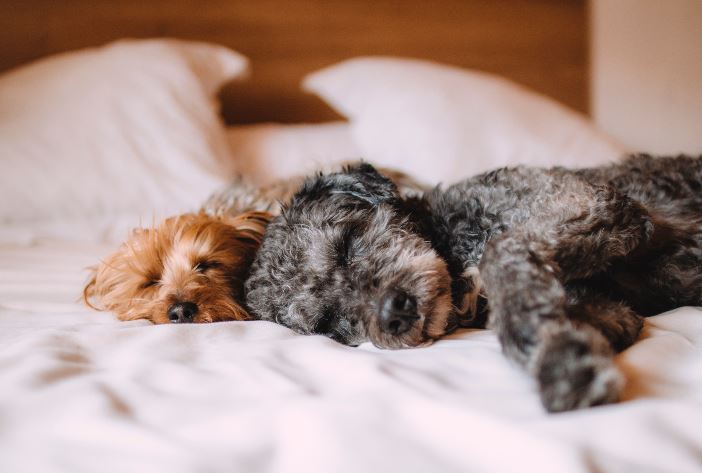21 LUMPS AND BUMPS OF THE CANINE SKIN

Dogs sometimes get bumps or lumps on their skin much like humans do. Nobody wants to see lumps on their dogs. Not only are they unsightly, but also may indicate a serious health problem. A veterinarian should be contacted without delay if a lump is noticed. Delaying is not in the best interest of your pet. Some lumps are benign and won't cause any problems to the dog. Others, however, may be a sign of cancer. Unfortunately, all lumps must be checked by a veterinarian to ensure that they aren't malignant. They can then decide what is best for you and your four-legged friend.
This article describes common benign lumps and bumps in dogs, along with the more sinister tumors that occur on the skin.
-
Wart
-
Papilloma
-
Lipoma
-
Skin Tags
-
Sarcoid
-
Hemangioma
-
Mast cell tumor
-
Sebaceous adenoma
-
Sebaceous cyst
-
Histiocytoma
-
Hemangiosarcoma
-
Pyogranulomatous Epidermitis
-
Malignant (cancerous) lumps and bumps
-
Angioma
-
Abscess
-
Squamous cell carcinoma
-
Granulomas
-
Mammary carcinomas (breast cancer)
-
Perianal adenomas
-
Lymphoma
-
Fibrosarcomas (soft tissue sarcomas)
Warts are growths of the skin that are more hard than soft. There are two types of warts, flat and raised. The treatment for a wart is usually freezing or cutting it off (curettage).
Flat WartThese are usually acquired from exposure to other dogs and walking in infected locations. These can simply be frozen off, or cut out if done at an early stage of development.
Raised WartThese warts are generally acquired by a dog being bitten or scratched by another animal. These warts are more difficult to freeze and may require cutting out as well.
This is a wart-like tumor that can occur on the mouth, lips, eyelids, tongue, and nose of dogs. The tumor contains rapidly growing cells which makes it more malignant than your average wart or skin tag.
Treatment for papilloma's usually includes surgery to remove them but laser therapy has also been used effectively in some cases. If you have any other questions about these types of lumps and bumps please feel free to ask your veterinarian.
These are fatty tumors that usually occur over the back, by the top of the rump, shoulders and near the tail . The size is anywhere from a pea to 2 inches across. The treatment for Lipoma includes a surgical removal.
This resembles fatty tissue but because of its position in between skin layers it may resemble a lip which leads to its nickname "fatty tumor". One spot can have more than one lipoma at a time. The treatment is surgery because they are benign (not cancerous) and grow very slowly although if left untreated they can get larger and feel harder under the skin.
They are usually painless unless broken open from constant rubbing but then an inflammatory reaction could occur. This lump should be checked out by your vet immediately if you notice any change or redness (inflammation).
This is also called acrochordons from Greek meaning 'stalked body'. They are small skin growths that emerge from beneath your dog's skin and hang down like a string or stem (stem warts). Most veterinarians do not remove them because they eventually fall off on their own. Dogs get them mostly on their face and ears, but they too can appear anywhere else. These are commonly removed only if they become irritated or infected.
This lump or bump is not a skin disease, technically speaking, it is a result of the dog's immune system reacting to an irritant in the body such as toxic material from her diet (excessive pesticide exposure), infections like parvo virus etc. They come in three different forms; Alveolar (or nodular) sarcoid, which appears very much like small lumps under the skin surface; It usually takes about 12-18 months before this kind of sarcoid becomes visible.
This type of tumor has been known to pop out on any area of the dog's body but tend to appear on their skin and also around the anus area. They are about 1"-4" in diameter when they first surface and will take anywhere from 2 months up to 3 years to grow fully.
This type of tumor is a cancerous growth and rare to be seen in dogs. It looks like small ulceration on the skin or massive lumps under it. If your dog has this type of tumor, it is important to seek a veterinarian's help as soon as possible.
Treatment for mast cell tumor depends on the size, location and aggressiveness of the tumor. Some mast cell tumors can be treated with local surgery but other may require chemotherapy or radiation therapy.
This is also called sebaceous carcinoma, this skin disease appears as multiple lumps all over your dog's body (and sometimes even inside his mouth). The most common symptoms related to this disease are scaly areas of skin that look like crusty sores that might bleed. This cyst might be dangerous for your dog if not checked by the vet.
This is a small skin growth that does not appear dangerous to your dog but becomes a problem in case when it is growing rapidly or causes discomfort to him (because of its size). Usually, these are small bumps under the skin and you can notice them right away. If this is happening with your pet, do not wait too long before taking him to the vet.
This kind of tumor is not malignant but deep under skin tissue and appears as a reddish discoloration of the skin, small in size. They are usually benign and have a low rate of recurrence if treated properly by your vet.
Is another type of cancerous growth found on your dog's skin. It has a red coloration with dark red or purple spots on its surface which usually appear suddenly without any warning signs. They can either be small or large in appearance and may grow fast depending on how advanced they are when first discovered, hence immediate veterinary treatment should be sought out.
Is a type of skin tumor that is usually red in color and shows up more commonly in dog's older than 5 years old. It can appear on a variety of different spots on your fur baby's body such as the lip, head or neck area, but it does not have any spread to other organs unlike most cancers do.
These tumors can occur anywhere on the body and are solid masses. Most often, they are firm , round (or oval) tumors that are movable and painless to your dog. The first sign is usually when you notice a change in your dog's size or a swelling of one leg or side of his body that does not go away with regular treatment.
These types of lumps or bums are more serious in animals because they are malignant. Malignant tumors require prompt attention and treatment by a veterinarian, if your dog does not pass away before you can get him there.
The angiomas appear as pinkish red masses beneath your dog's skin. The most common places are the nose, lips and eyelids. This type of tumor is benign (not cancerous) but, like melanoma tumors, they can be hereditary. If this does not sound like your dog's lump or bump at all, you should still have it checked out by your vet as soon as possible.
These can be painful or non-painful depending on how acute it is. They develop after an area of the skin has been injured by a splinter, thorn or some other type of foreign object. The body's response is to wall off and isolate the area with a collection of dead cells, fluid and bacteria so as not to spread infection throughout the entire body. A dog with an abscess may limp slightly if it's located on his paw or leg but this lump should be checked out by your vet regardless whether you experience any pain symptoms from him.
This type of skin cancer starts in the top layers of skin and is more common in dogs with light-colored hair. Squamous cell carcinomas are most often found on parts of the body that have been exposed to sunlight over prolonged periods of time. This type of skin cancer is highly treatable when caught early but if it's allowed to grow, it can invade other tissues surrounding it (i.e., spread).
Granulomas are caused by the body's immune system fighting off an infection (i.e., foreign invaders like bacteria, fungi and parasites). Granulomas can look like small lumps or even slightly raised pink patches of skin. If you notice a growth that doesn't seem to be going away on your dog you should consult with your vet as granulomas are fairly common in dogs and they might need medication to clear them up.
These are particularly common in female dogs (esp. intact females) and they can vary drastically in size from small lumps that are only slightly raised to grotesquely large masses of tissue. The larger the mass, the more likely it is that malignancy or cancer has set up shop inside of it (the breast tumors pictured above are both benign). Mammary cancers can look like hard, round nodules or even fleshy lumps with a particularly bloody discharge if they have ruptured through the surrounding skin. Other symptoms of mammary cancer include lethargy, loss of appetite, inflammation around the tumor site and an increased risk for developing infections at the tumor sites.
These are benign tumor growths that develop in the area around a dog's anus. They are sometimes referred to as pilonidal cysts, and can be very itchy for your pet. You should bring your dog to your vet if you notice one of these lumps forming.
These kinds of tumors are the same as cancer. Signs include swollen lymph nodes, fever, and general loss of energy. A veterinarian will advise you to treat this condition with chemotherapy as it is very serious and can be fatal in a relatively short time.
Fibrosarcomas are malignant, fast-growing tumors that begin within the skin and deep tissue. They are common in large breed dogs, especially Doberman pinschers, golden retrievers, German shepherds, Labrador retrievers, Rottweilers and boxers. The median age for a dog to develop this tumor is 7 years.
Types of treatments used for these types of lumps and bumps
- Gene Therapy
- Antiangiogenic Therapy
- Laser Therapy
- Immunotherapy
- Metronomic Therapy
- Multimodal Therapy
- Photodynamic Therapy
I hope this article was helpful. If you have any more questions, please reach out to your vet and they'll be happy to answer them for you.




